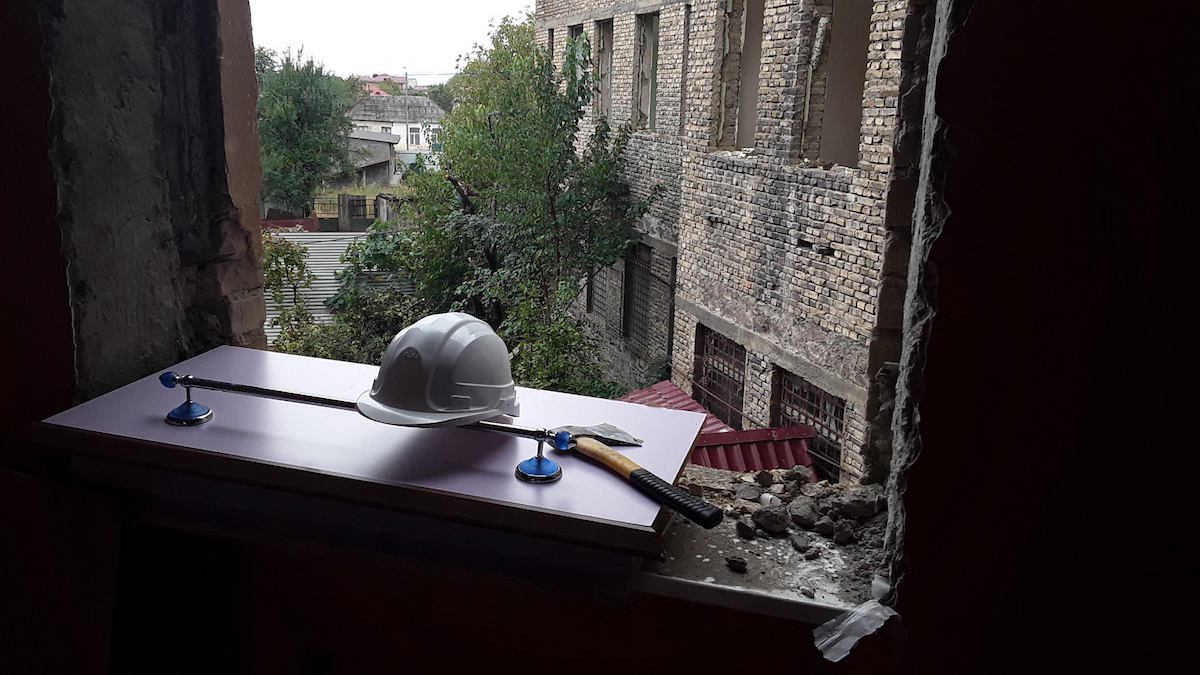Drivers and security guards are in-demand in South Ossetia, while lawyers and economists are not

“I got married at an early age. When I was 24, I’d already had 4 children. I was actually forced into marriage. I was kidnapped by my future husband and his friends. Therefore, our relationship was soured from the very beginning. Besides, he often drank and we finally got divorced.”
Zinaida Zasseeva is 53 now, and works as a cleaner.
“Having been left alone with the children, I went to the printing house and asked for a job. It was very convenient: I did everything in the morning and then I was free. I could look after my children, and also started sewing wool mattresses on order at home. I still sew them, since people always need them. If I process, wash and dry wool myself, then I charge RUB 2 500 [about USD 45], but if I just sew them, then RUB 1 000 [about USD 17].”
This story is essential to this article, which aims to get an insight into one of South Ossetia’s most pressing problems – unemployment.
JAMnews asked people the following question: which is better – to continue studying or start working straight away? And if it’s better to study first, then what major should one choose in order to find a good job and build a career?
Zinaida’s answer to this question turned out to be quite typical:
“I don’t think it’s important to get higher education nowadays. A woman actually needs a diploma as a dowry. It’s hard to find a job at public institutions, and the factories here aren’t operating. We should create job opportunities ourselves.”
Statistics
Although there are official statistical data on unemployment rates in the republic, the data is pretty old, for the most part unreliable, and practically useless.
In 2016, the number of unemployed who had registered with the aforesaid service increased to 4 064 people, and only 67 of them found a job with assistance from the employment service.
However, those figures can’t be regarded as real statistics, since they are very inaccurate.
Up until 2007, unemployed individuals received 46 roubles a month – less than USD 2 at that time. Later on unemployment benefits were cancelled. Since the number of people who found a job via the help of an employment service had always been scanty, many people lost their last incentive to waste their time on registering as unemployed.
Thus, the aforesaid statistics don’t reflect the real picture. The only thing left is to rely more on one’s personal observations and assessments made by various sources. Based on those sources it may be concluded as follows:
• The unemployed make for about 20% of the total population;
• An average salary of a public institution employee amounts to RUB 13 500 (about USD 230);
• As for the rest of the people, an average salary is around RUB 11 500 (about USD 195).
The most in-demand jobs in South Ossetia are as follows: a cleaner and a security guard in public institutions, and a driver (and also a security guard) in the private sector. Well-educated people with good service records from some state agencies could often be found serving in the aforesaid capacity in South Ossetia. They are better paid in the new field.
Economists and lawyers are the least in-demand jobs in South Ossetia
The majority of Tskhinval residents consider these two professions as the most ‘useless’ ones.
Alexander Kulumbegov* says that he regrets wasting so much time studying at his university’s economics faculty. “I couldn’t find a job in my degree field as all positions are occupied,” he said.
So he decided to change his major. He enrolled at a vocational school in Tskhinval and is now acquiring a ‘construction finisher’s’ skills.
Other popular majors in this vocational school are: construction and operation of buildings, needlework, road and building machine maintenance, electricity-related activity and some similar professions.
The cooking/confectionary department is also very popular. As vocational school students told JAMnews, the problem is that chefs aren’t required to produce their diplomas when seeking employment at a café or a restaurant in South Ossetia. “If the rules had been observed, there would have been tough competition at this faculty,” said the students.
There are few jobs, but many combine several ones
Lyana Tedeeva, an occupational safety specialist, works at the population employment department. She says that quite the opposite situation, i.e. when people work on two or even three low-paying jobs, trying to survive somehow, is also similar to unemployment.
“Part-time employees such as teachers, singers, dancers and scientists can combine several jobs. However, when a person simultaneously works in several places, he/she physically ‘runs’ to and fro, from one job to another, during the day. In this case a person can’t do his job in a quality manner,” says Liana Tedeeva.
Young specialists
Young specialists, i.e. a ‘product’ of the special ‘quota system’ that was introduced here in 2006, seems to be in the most difficult situation. Quotas are places at Russian universities allotted to a certain number of applicants from South Ossetia.
Usually there are about 120-130 of them annually.
Students who are allotted such a ‘quota’ place travel to study in one of Russia’s cities, but before that they conclude an agreement with the South Ossetian Education Ministry. As is pointed out in the aforesaid agreement, a student undertakes to return to the republic and work there after graduation.
Although many of them return, it’s particularly difficult for them to find a job. Young professionals aren’t employed allegedly due to a lack of experience. As a result, in 2011, the Education Ministry decided to stop concluding the aforesaid contracts.
Sergei Zassev is the Chair of the Youth Policy, Sports and Tourism Committee of South Ossetia. According to him, about 150 young people, who in due time were sent to study at Russia’s universities on quotas, have been waiting in line for vacancies since 2014:
“Regrettably, the tourism sphere isn’t developing in our country, and it’s the same with the youth policy. The situation in the sports sector is slightly better: we provided jobs to 10 people in 2016.”
Many people view the problem as the fact that the majority of employees in many agencies are pensioners who can’t always do their job in a quality manner, but flat-out refuse to resign and can only be dismissed through court.
What are the underlying causes of the current situation?
The collapse of the USSR and the Georgian-Ossetian war in the early 1990s are named as the main causes of mass unemployment in South Ossetia. The long-established economic ties were broken off, the railway ceased operation and many years passed amid the acute economic crisis.
‘Little’ South Ossetia was affected more than the ‘big’ post-Soviet republics. Numerous plants and factories were operating in South Ossetia, including the Tskhinval brewery, a sawmill, the ‘Bagiata’ mineral water manufacturing plant, a knitted undergarment factory, a dairy factory, a mechanical plant, a branch of Tbilisi aviation, as well as the Electrovibromashina and Emalprovod factories.
Nearly all of these enterprises were shut down and their equipment plundered. Only a few of them have survived until now, but their operating capacity is just 5-10% when compared to the past. For example, let’s take the story of the knitted undergarment factory.
It was opened in 1962 and about 1 200 people were employed there at the time. The factory ceased to operate in 1991. Later, in 2002, a shopping centre was made there. The factory resumed operating in 2014, this time as a branch of a St Petersburg-based company, with 520 people currently employed there.
It’s a very successful example, though a rare one.
The consequences of unemployment
The consequences of unemployment are approximately as follows:
• A lack of skilled specialists in all fields;
• A drop in the service level in all fields;
• Vague development prospects.
“In 2016, my daughter, Zarina Jioeva, graduated with honors from Moscow Institute, with a degree in landscape design. She came to Tskhinval and started looking for a job. Having failed to find one, she returned to Moscow,” said Angela Nartikoeva. “I imagined her life quite differently. I thought she would return, find a job, get married, give birth to my grandchildren, and I would help her while she would be engaged in her favorite occupation.”
Youth migration from South Ossetia should be placed on top of the list of the most pressing problems that the republic is facing as a result of unemployment. People talk about it, though only lightly.
However, official statistics prove the opposite. The figures are as follows: 100 people left the republic in 2016, with 1 120 people arriving.
As the locals told JAMnews, the republic has seen an increase in the number of labor migrants, mostly from Tajikistan, Kyrgyzstan and other post-Soviet countries of Central Asia. The migrants from the aforesaid republics are employed in construction, or they start up their own businesses, including small shops, in Tskhinval.
Private business as a way out
Several years ago, Zinaida Zasseva, the cleaner at the printing house, added one more conditional ‘business’ to her rather successful wool mattress sewing enterprise. She organized a construction brigade and started repairing flats. She worked in the brigade herself, though she acted more as a brigade supervisor.
“We mostly refurbish apartments. However, if a client requests the installation of a wiring or plumbing system, I immediately find a specialist and commission a turn-key finished apartment to the client,” she said.
According to Zasseeva, she always gets up at 3:30 a.m. and goes to bed at 09:30 p.m. in order to run her businesses successfully. “I’ve gotten used to it,” she noted.
However, there are few entrepreneurs who run their businesses in such a manner.
“R
egrettably, there aren’t proper conditions for the development of small and medium businesses in South Ossetia,” said Yuri Vazagov, an economist and journalist.
It is the same context everywhere, worldwide – first of all, people need cheap and long-term loans to start up their businesses. As for South Ossetia, businessmen and farmers can get either a National Bank loan under 12% annual interest rate for a maximum period of 5 years, or a Sberbank loan at as much as a 16.5% annual interest rate.
It is noteworthy that the sum issued to legal persons does not exceed 70% of their ‘mortgage’ value (as a rule, the banks demand immovable property as collateral), while the amount issued to private individuals doesn’t exceed 50%.
“Business is unlikely to develop in such conditions,” said Yuri Vazagov.
In his opinion, there are three major trends that could promote business development in South Ossetia and make the educated and experienced youth stay in the republic.
• South Ossetia is an agrarian republic and it would be good to set up a specialized bank to finance agricultural projects;
• It is necessary to ensure favorable loan conditions;
• State funds should be used to finance accounting, business operations and management training courses for young entrepreneurs willing to start up their own business.
Export
“Everything that is now operating in South Ossetia is mostly oriented towards the domestic market. However, the Alliance and Integration Treaty, concluded with Russia in March 2015, provides for preferential conditions for exports of South Ossetian products (except for alcohol and cigarettes). It’s a good prospect for the development of local entrepreneurship,” stressed Vazagov.
For example, the production of some famous Italian brands can be launched at the Tskhinval-based sewing factory. Bulk production, as well as processing and export of agricultural products can also be planned and organized.
South Ossetia can export beer and other alcohol products to Russia. Local brands can be created with a focus on eco-friendly products in order to withstand competition.
Russia’s investments in South Ossetia helped to set up the aforementioned sewing factory.
Rosdon, a new turkey-meat processing plant, was opened through Russian investments in 2017, offering job opportunities to about 50 people.
However, many experts are unanimous in the opinion that development of local entrepreneurship is the only thing that can reverse the situation.
In October 2016, the South Ossetian Parliament passed a law on preferential loans for small business entities. It suggested setting up a special fund to facilitate the issuance of preferential loans for private businesses in several fields, including:
- production, processing and selling of agricultural products;
- artisan craftworks;
- education;
- medicine;
- public catering;
- innovations;
- tourism;
- hospitality business.
A person, willing to start up an individual business in the aforesaid and some other fields, will be entitled to get a loan at a 5% (and lower) annual interest rate for a period of 3 years. The loan may cover the total value of the collateral given (usually immovable property).
Like many other residents of the republic, Zinaida Zasseeva is looking forward to the moment the bill is signed into law by the president.
“My children have grown up. As for me, I’ve never intended to marry again, especially now. What do I need that for? Why should I do the washing-up for someone? I’m going to further develop my business,” she stressed.
When she was a teenager, Zinaida Zassaeva dreamt of becoming a Physical Education teacher. Although her dream didn’t come true and she is unlikely to become a teacher now, she has built a small swimming pool in her backyard, beyond her vegetable garden. “I’m actively engaged in sports too,” she said.



















